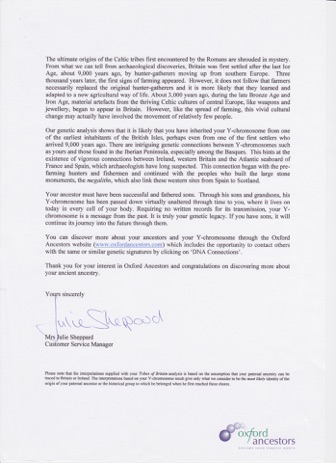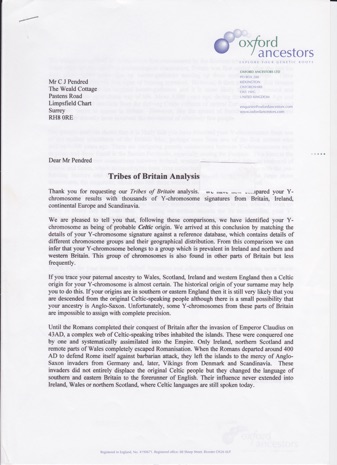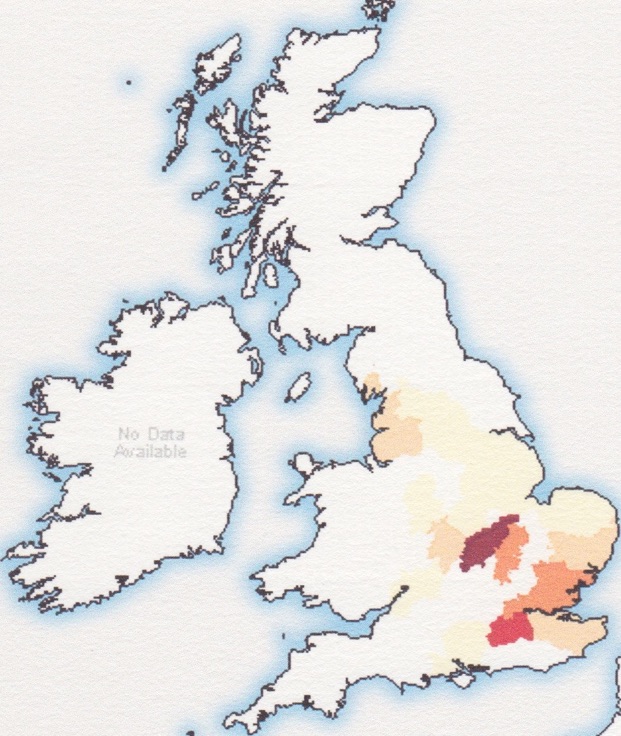



Do PENDREDs’ have Celtic British origins?
It may not be the same for all male Pendreds, but according to my DNA profile produced by Oxford Ancestors. www.oxfordancestors.com my roots are Celtic British. Christopher Pendred - Limpsfield, Surrey, England.
This came as quite a surprise because I had suspected Anglo-Saxon roots as the well known ‘moneyer’ Pendred made coins for the Anglo-Saxon King Offa in the 9th century.
This is the report that Oxford Ancestors sent to me.
Was the PENDRED a member of the Cornovii tribe?
When I became aware of the Pendred coin produced for King Offa in the 9th century, I thought it likely that Offa would have chosen an Anglo-Saxon to design and make his money, especially this rare gold coin.
Research into my family history has shown that my ancestors lived in Northamptonshire. Only a stones throw from the seat of Offa’s power in 9th century Mercia.
This area was previously the homeland of a Celtic tribe know as the Cornovii.
Click here to skip to a page on this site devoted to the Cornovii.


In 2006, before the data protection act, Oxford Ancestors were able to research a number of public registers. At that time in 2006 only 164 PENDRED’s were recorded on these registers in Great Britain.
Oxford Ancestors now have a product ‘MyMap’ which uses information gathered in the 1881 census of Great Britain. The earliest census from which people shared a surname was counted and placed on a map. In 1881 a total of only 175 PENDRED were recorded as living in England and Wales (including Cornwall).
In 1881 Pendreds were located in the following parts of Britain:

On this 1881 map of Britain the following PENDREDS were recorded:-
Northamptonshire 56
Surrey 22
Middlesex 15
Bedfordshire 12
Essex 11 In all Britain only - 175



Comment.
Evidence derived from Christopher Pendred’s DNA indicated that he and presumably other Pendreds are not Anglo Saxon or Norman but derived from the first inhabitance of these lands as the ice receded after the last ice age 10.000 years ago and before sea levels rose as the ice continued to melted and cut Britain and Ireland off from the main continent of Europe.
Numerologists have suggested that as gold coinage was not in circulation for decades after King Offa, and after Offa became a Christian he wanted to make his part of Britain part of the Church of Rome. He may have had some gold coins specially made to pay Britain’s annual subscription. But whether a mancus or not Numerologists feel convinced that both the Pendred and the Ciolheard were intended to be coin, struck probably, like the gold coin ordered under King Eadred’s will for the specific purpose of making alms either to English churches or to the Holy See in Rome.
For this reason and as the moneyer Pendred was most likely of Celtic British decent I offer the following story just for fun!
1/. Offa’s kingdom incorporated Mercia and stretched from Blackpool and the border with wales east to the river Humber, south to Gloucestershire and east to include central England, Norfolk, Suffolk, Essex, Kent and Sussex.
The Pendred ancestral lands centralise in Northamptonshire well in the centre of Offa’s Kingdom.
2/. One of the family myths handed down to me by my father and his father before him is a connection with Cornwall. However I have found no evidence of any Pendreds ever living in Cornwall or the west country. However the British Celtic Cornovii tribal lands stretch up the border with Celtic Wales from Wroxeter (Viroconium Corniovorum) in the south to Chester (Deva) in the North and incorporated a lot of Cheshire and Shropshire. Perhaps the myth is a connection with the Cornovii not Cornwall?
3/. If the moneyer PENDRED was Celtic British and living in central Britain he may have had ancestral connections with the Cornovii. If he did he would have known about Cornovii history and the unique Cohors Prima Cornoviorum.
4/. For this reason, PENDRED may have substituted the Pagan Goddess Diana shown on the prototype Roman ‘Aureus’ of the coin he was commissioned to make, with a depiction of a Cornovii Roman army auxiliary soldier. The similarity is striking. The head is turned to one side, the right arm crooked holding a spear (contus) and the left hand an oval shield, the figure wears a helmet, short chain mail or woolen tunic gather by a belt and coming down to the knees. Identical to a roman soldier of the 4th. century AD
